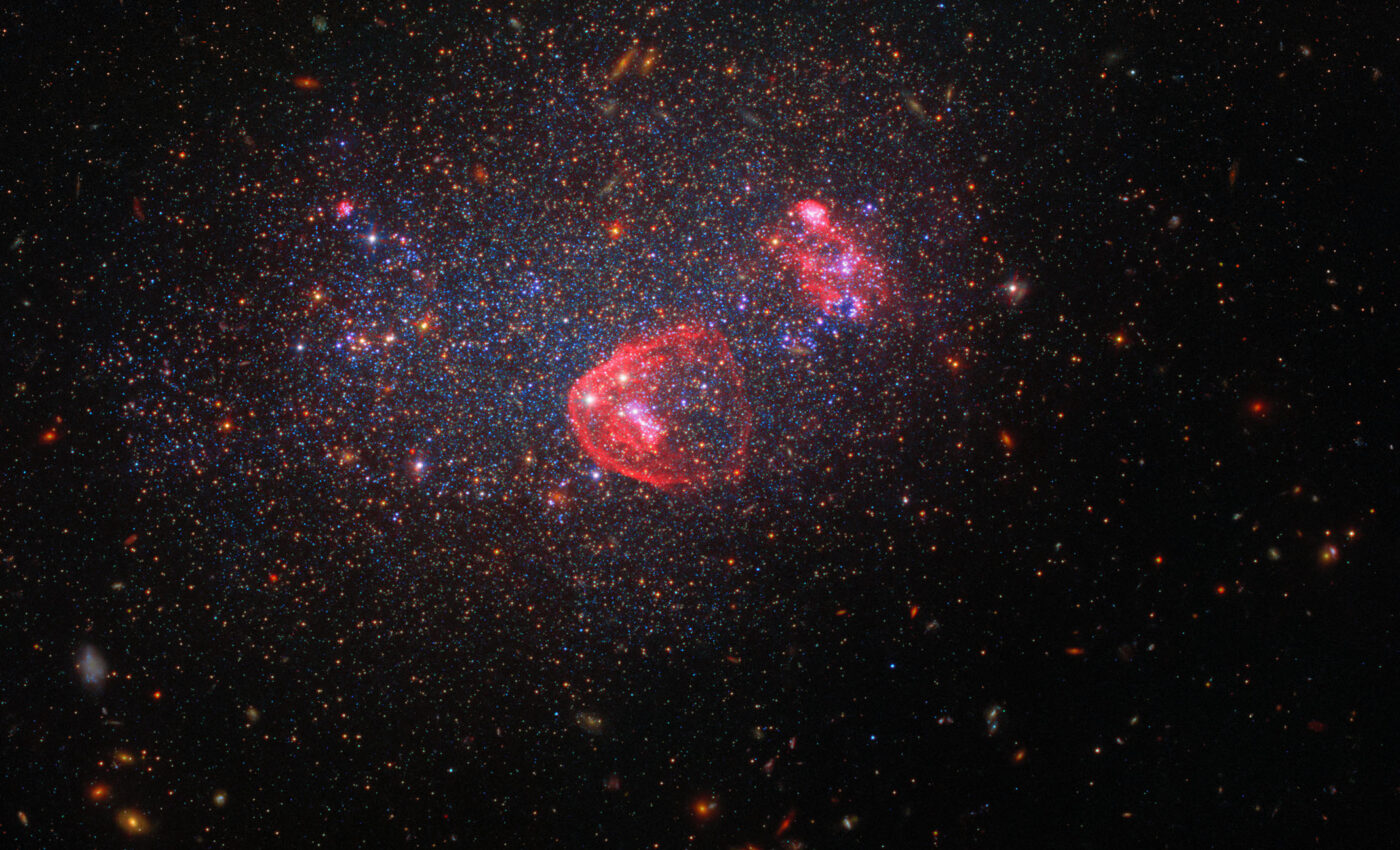
Hubble captures the festive spirit of galaxy UGC 8091
The universe, through the lens of the Hubble Space Telescope, often resembles a perpetual holiday celebration, and the dwarf irregular galaxy UGC 8091 is a prime example of this cosmic festivity.
In a mesmerizing display, the galaxy bursts into life with brilliant blue stars, akin to a celestial string of festive lights. These newborn stars are cradled in vibrant, pink hydrogen gas, glowing with an ethereal light. UGC 8091, albeit small in cosmic terms, is a bustling community of around 1 billion stars.
This number might seem vast, yet it’s only a fraction — about 1/100th — of the stars found in our larger, mature Milky Way galaxy.
UGC 8091’s late arrival to the galactic scene
UGC 8091, located some 7 million light-years away in the constellation Virgo, has arrived somewhat late to the galactic assembly. In the universe’s formative years, dwarf galaxies were abundant, gradually merging over eons to form the spectacular spiral galaxies we see today. UGC 8091, however, has only recently begun to unveil its own cosmic tapestry, an intricate and glittering spectacle.
This galaxy’s appearance in the Hubble image is akin to a sparkling snow globe, a collaboration between NASA and the European Space Agency. Its irregular shape, lacking the structured spiral or elliptical form of many galaxies, gives it the appearance of a luminous tangle of string lights more than a traditional galaxy.
The diversity of irregular galaxies is fascinating. Some are shaped by internal turmoil, while others bear the marks of interactions with neighboring galaxies. This results in a wide variety of sizes and shapes, as seen in UGC 8091’s diffuse scatter of stars.
A technological marvel from Hubble
The image we see is a composite, meticulously crafted using twelve camera filters, capturing light from the mid-ultraviolet to the red end of the visible spectrum. The red areas likely represent interstellar hydrogen molecules, glowing in response to the light from energetic, hot stars.
Mixed in are older stars, adding to the galaxy’s sparkle. In the background, Hubble’s sharp vision brings into focus an array of distant and diverse galaxies.
This image represents data collected by Hubble’s Wide Field Camera 3 and the Advanced Camera for Surveys, spanning from 2006 to 2021. It’s a part of observing programs aimed at understanding the role dwarf galaxies played billions of years ago in re-heating hydrogen as the universe expanded post-Big Bang.
Astronomers continue to delve into the nature of dwarf galaxies and their stars. Their goal is to unravel the evolutionary links between these ancient celestial bodies and more modern galaxies, like our Milky Way, enhancing our understanding of the universe’s grand tapestry.
More about galaxy UGC 8091
As discussed above, galaxy UGC 8091 is a dwarf irregular galaxy. Residing in the constellation Virgo, it stands as a testament to the diverse and intricate nature of our universe.
Irregular beauty of UGC 8091
Situated 7 million light-years from Earth, UGC 8091 occupies a relatively close position in our cosmic neighborhood. Despite its proximity, this galaxy differs significantly from the Milky Way, both in size and structure. It hosts about 1 billion stars, a mere fraction of the Milky Way’s stellar population.
The irregular classification of UGC 8091 stems from its lack of a defined spiral or elliptical shape, common in larger galaxies. This unique structure likely results from a combination of internal dynamics and external interactions with nearby galaxies.
A latecomer in galactic evolution
UGC 8091’s formation and development offer a glimpse into the early universe’s dynamics. Dwarf galaxies like UGC 8091 played a crucial role in the evolution of larger galaxies, often merging and coalescing to form the majestic spirals and ellipticals we observe today.
The galaxy is a vibrant tapestry of star formation. Newborn stars illuminate its expanse with brilliant blue hues, surrounded by glowing hydrogen gas. This stunning visual spectacle resembles a cosmic festival of lights, revealing the ongoing processes of stellar birth and development.
The Hubble Space Telescope’s role
The Hubble Space Telescope has been instrumental in revealing the intricate details of UGC 8091. By utilizing a range of camera filters, Hubble captures the galaxy’s light across the electromagnetic spectrum, providing invaluable data for ongoing research.
In summary, as astronomers continue to study UGC 8091, they aim to unlock more secrets about dwarf galaxies and their role in the broader cosmic narrative. This research enriches our understanding of the universe and places galaxies like UGC 8091 in the grand tapestry of cosmic history.
—–
Like what you read? Subscribe to our newsletter for engaging articles, exclusive content, and the latest updates.
Check us out on EarthSnap, a free app brought to you by Eric Ralls and Earth.com.
—–













